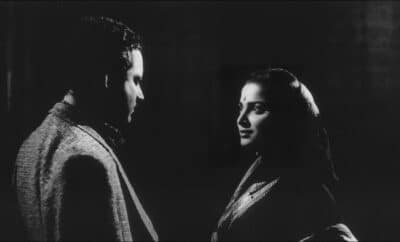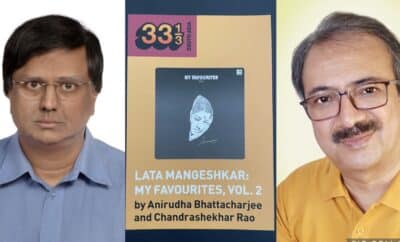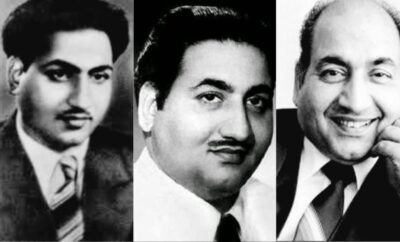Collections
Kavi Pradeep – Rare Romance in the Sage’s Poetry
“Beti, aaj tumne mujhe rula diya!” (Girl, your rendition filled my eyes with tears), said the then Prime Minster of India, Jawaharlal Nehru to Lata Mangeshkar sixty-one years ago, on 27th January 1963, when she rendered “Aye mere watan ke logon” in front of a colossal audience in Delhi, to pay tribute to the martyrs of the famous India – China war. Thousands of throats were choked, and several thousand pairs of eyes started tearing!
Instantly sensing the immense potential of public appeal that the song had, which had gone up multi-fold due to Jawaharlal Nehru’s reaction, HMV seized the opportunity and released a private 78 RPM record of the song. And the song became all the rage in no time. There was no public performance by Lata Mangeshkar since then, where the audience did not insist on this song. It continues to be an epitome of patriotism even after six decades and we still hear it all over on every Independence Day and Republic Day.
Lata Mangeshkar’s rendition is no doubt soul stirring and never fails to provoke patriotism. But hardly anyone from the current generation remembers C. Ramchandra, the composer of this heart-rending song, and Kavi Pradeep, whose words inherently carry the emotions, in which Lata Mangeshkar has put her heart and soul.
If we look at Kavi Pradeep’s repertoire of songs, it seems that there would have been no better choice of lyricist for this song. He is best known for his patriotic, philosophical, mythological and devotional songs, like “Door hato aye duniyaawaalon, Hindustan hamaara hai” (Kismet – 1943), “De dee humen aazaadi bina khadga bina dhal” and “Aao bachchon tumhen dikhaaye jhanki Hindustan ki” (both from Jagriti – 1954), “Tere dwaar khada bhagwaan” (Waman Avtar – 1955), “Insaan ka insaan se ho bhaaichaara” (Paigam – 1959) and “Main to aarti utaaroon re Santoshi maata ki” (Jai Santoshi Maa – 1975)
Born as Ramchandra Narayanji Dwivedi on 6th February 1915 in the small town of Badnagar near Ujjain, he had a flair for poetry since early years. He would engross the audience in Kavi Sammelans in his inimitable style. He used to write the poems under the pen name Pradeep, which he continued to use as a lyricist too. Film director N. R. Acharya was impressed with Kavi Pradeep’s poetry while he was reciting a poem in a Kavi Sammelan in Mumbai. He introduced Kavi Pradeep to one of the founders of Indian cinema, Himanshu Rai from Bombay Talkies, who was also impressed and offered him to write the songs for Kangan (1939). He wrote four songs for the film, which became very popular. He also sang three songs for the film. Next, he wrote all the songs for Bombay Talkies’ Bandhan (1940) and embarked on his success spree. The most notable song from Bandhan was “Chal chal re naujawaan”, which created waves in the Indian freedom movement. The youngsters from Punjab and Sindh regions of undivided India were so overwhelmed with the song that they wanted the song to be declared as the national anthem and started a movement for this. Mahatma Gandhi’s close associate Mahadev Desai found this song no less powerful than a mantra in the Upanishads.
Thereafter he wrote songs for several films in the 1940s. His patriotic song “Door hato aye duniyaawaalon, Hindustan hamaara hai” (Kismet – 1943) also made a history. The audience in the film theatres would keep on shouting “once more” as soon as the song would end. The reel then would have to be rewound again and again several times to satisfy the public demand. The British soon realised the true meaning of the song and issued an arrest warrant for Kavi Pradeep. He had to then be underground for avoiding arrest.
His next milestone was Mashaal (1950), the film with which S.D. Burman’s career as a composer took off and Manna Dey also gained fame as a singer with “Upar gagan vishaal”. This film also marks Lata Mangeshkar’s entry into the Burman camp.
Kavi Pradeep was at the acme of his career in the 1950s. His notable films during this decade include Jagriti (1954), Nastik (1954), Waman Avtar (1955) and Paigam (1959). While he worked with many a composer during his career, his association with C. Ramchandra gave us many remarkable songs. His uncomplicated lyrics with simple language were easy to understand for everyone. However, with the changing trends in Hindi film music in the 1960s, when western music and fast numbers started taking precedence, Kavi Pradeep became an odd man out and his career as a lyricist started waning. His noted work after the 1950s is Sambandh (1969) marked by a rare combination of Kavi Pradeep, O.P. Nayyar and Mukesh, and Jai Santoshi Maa (1975).
Besides being a prolific poet, he was also a good singer. Songs like “Dekh tere sansar ki haalat kya ho gai bhagwaan” (Nastik) and “Tere dwaar khada bhagwaan” (Waman Avtar) are good examples of singing skills. He received the “Best Male Playback Singer” award for “Yahaan wahaan jahaan tahaan” (Jai Santoshi Maa) from the Bengal Film Journalists’ Association.
Due to his seniority and simple appearance in white dhoti and kurta, he often seemed like a sage. His personality also often reflected in his songs conveying deep meaning in simple words. However, as a Hindi film lyricist, he could not keep away from light romantic songs and thus romance is seen peeping in his songs occasionally. Here is a quick ride through his romantic songs.
1. Dheere Dheere Aa Re Baadal (Kismet – 1943)
This is a beautiful tandem song with two version – the duet sung by Ashok Kumar and Amirbai Karnataki, and the solo sung by Amirbai Karnataki. The songs are composed by the Bheeshma Pitaamaha of Hindi film music, Anil Biswas.
2. Kuchh Sharmaate Huye (Girls’ School 1949)
A pretty song expressing the realisation of falling in love in Lata Mangeshkar’s nascent yet adept and nuanced rendition under Anil Biswas’ baton. The lyrics have some unique words that would not be usually found in the film songs.
3. Aankhon Se Door Door (Mashaal – 1950)
One of the first two songs that Lata Mangeshkar sang under S.D. Burman’s baton, which probably laid the foundation for their long lasting magical association. Romance in Kavi Pradeep’s sweet words sounds sweeter in Lata Mangeshkar’s voice.
As Kavi Pradeep had a good musical acumen, he would not only write the songs, but also put them to tunes and sing them to the composers. It is said that during the making of the music of Mashaal, S.D. Burman gave him a friendly advice that the composers would avoid him if he continued doing so and suggested that he should focus only on lyrics writing. He accepted the advice and adhered to it thereafter.
4. Jhuki Jaaye Nazar (Nastik – 1954)
A sugar candy composed by C. Ramchandra with honey dipped rendition by Lata Mangeshkar, filmed on lotus eyed Nalini Jaywant and Ajit.
5. Kisi Ke Do Chamakte Nayan (Naag Mani – 1957)
Another song expressing the realisation of falling in love, this time in Asha Bhosle’s adorable rendition, composed by Avinash Vyas.
6. O Dildaar, Bolo Ek Baar (School Master – 1959)
An endearing and foot tapping Lata Mangeshkar – Talat Mahmood duet composed by Vasant Desai.
7. Mere Jeevan Mein Kiran Ban Ke Bikharne Waale (Talaq – 1959)
A mellifluous semi-classical duet composed by C. Ramchandra and rendered by Asha Bhosle and Manna Dey proficiently. Beautiful beats of tabla are a remarkable element of soft and melodious orchestration.
8. Jawani Mein Akelepan Ki Ghadiyaan (Paigam – 1959)
A sweet and toe-tapping duet sung by Asha Bhosle and Mohammed Rafi composed by C. Ramchandra in his patent euphonious style, filmed on one of the most popular pairs of Hindi cinema – Dilip Kumar and Vaijayanti Mala.
9. Na Jaane Kahaan Tum The (Zinadagi Aur Khwab – 1961)
A mellisonant duet composed by Dattaram, adorned by Manna Dey and Suman Kalyanpur with their lovely rendition, filmed on Meena Kumari and Rajendra Kumar.
10. Akeli Hoon Main Piya Aa (Sambandh – 1969)
An Asha solo expressing the yearning for the beloved, composed by O.P. Nayyar with semiclassical touches.
Hope you enjoyed the glimpse of rare romance in the sage’s poetry.



